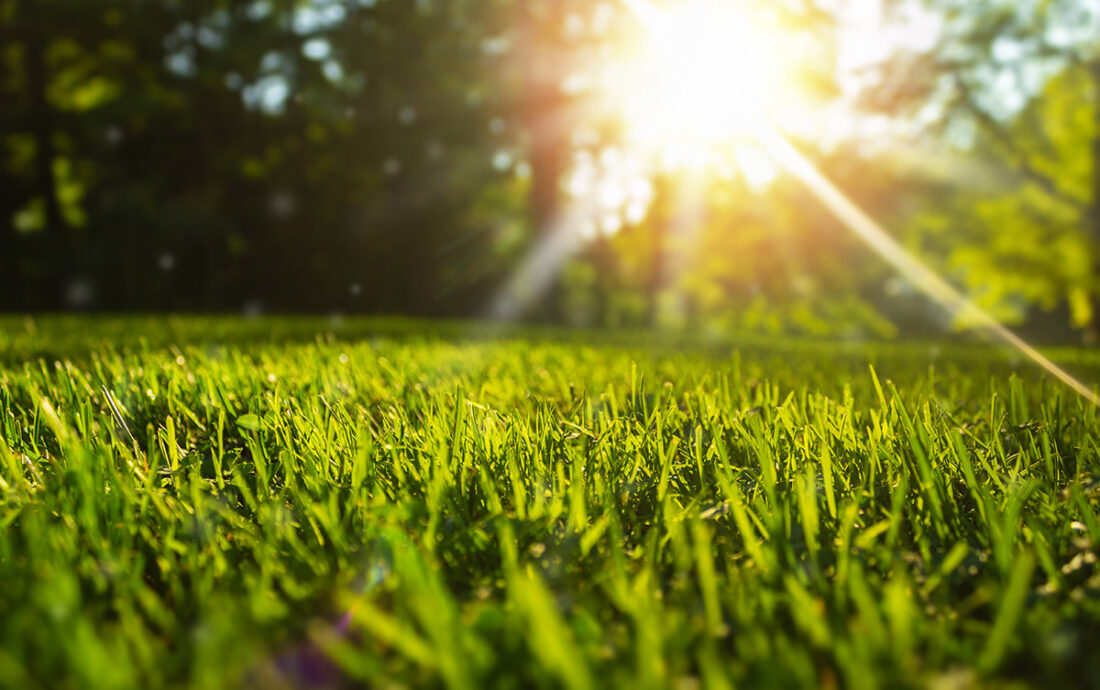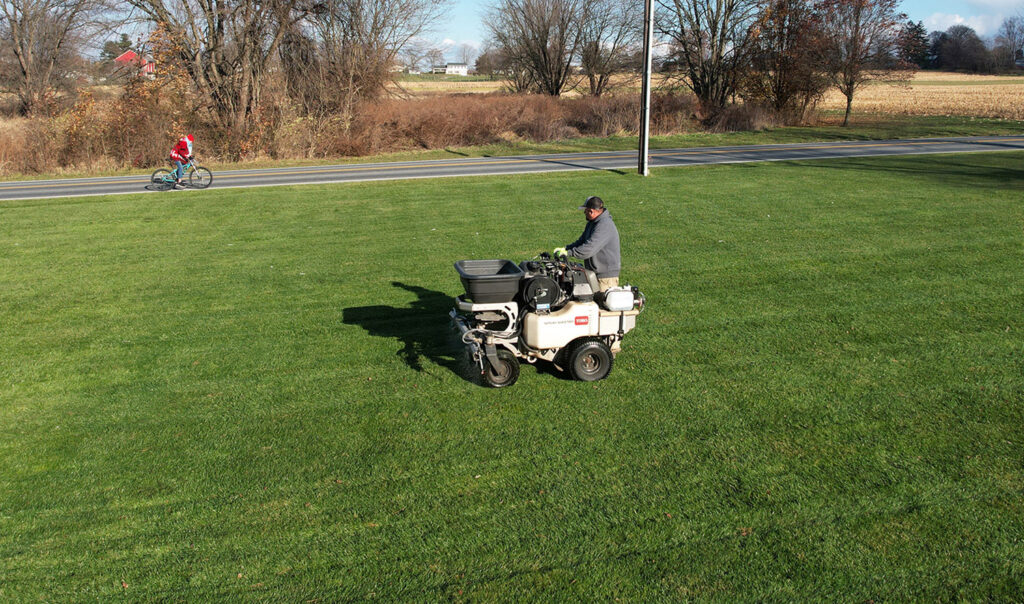
No matter if it’s your backyard, a business lawn, or the local athletic field, keeping grass green and weed-free from dandelions, clover, and chickweed can feel like a full-time job. But with the right timing and a simple plan, you can keep any lawn looking its best. Here’s what you need to know about when to weed and feed your lawn for healthy, weed-free turf.
A great-looking lawn shouldn’t be a headache. Whether you’re managing a backyard, a business property, or an athletic field, keeping your grass green and healthy takes the right approach—especially when it comes to tackling weeds. With proper timing, expert strategies, and reliable products, you can enjoy a lawn that looks amazing without wasting your time or energy.
A healthy lawn is your first defense against weeds. “When your grass is thick and well-fed it actually chokes out the weeds so they can’t grow. This is what you want. Because we’re based right here in Central PA, we know the perfect combination of fertilization, and timely weed treatments to keep weeds like dandelions, clover, and chickweed at bay,” said Jon Hubler, Founder and CEO of JHL Turf Pros. Whether you’re DIYing the job or hiring professionals to do it for you, timing is key.
When to Weed and Feed Your Lawn
Weeds like dandelions, clover, and chickweed can quickly take over a lawn if not addressed with the right timing and care. Applying weed and feed treatments correctly can keep these common Central PA weeds in check while giving your grass the nutrients it needs to thrive. Let’s break down the best schedule for weed and feed applications.
Timing Is Everything: Weed Prevention and Control
Applying weed and feed products at the right time is crucial for success. The schedule below is designed for Central PA lawns and helps target weeds at their most vulnerable stages while strengthening your grass.
First Application: Early April
Start your lawn care program in the first two weeks of April with a pre-emergent weed control product. This treatment creates a barrier that prevents weed seeds, like crabgrass, from germinating.
Also apply a post-emergent herbicide during this time to treat any weeds that may already be germinating from the spring.
Second Application: Late May/Early June
Reapply pre-emergent herbicides in late May or early June to reinforce your lawn’s defenses as the growing season ramps up. This second round is particularly important for keeping weeds like dandelions and clover from spreading.
Important Note: Pre-Emergent Weed Control and Grass Seeding
Pre-emergent weed control lasts approximately five months. You’ll need to wait until September to seed your lawn. Pre-emergent weed control is not targeted and will prevent ANY seeds from growing, including grass seed. Applying grass seed in April, immediately after a pre-emergent treatment, would be a waste of time and money.
Maintenance: Post-Emergent Weed Control
Throughout the growing season, it’s impossible to keep 100% of weeds away. The wind, birds, pets, and shoes can all carry seeds into your lawn allowing weeds to germinate. Once they’ve germinated, you’ll need post-emergent herbicide to get rid of them with targeted treatments. Addressing these weeds as they pop up will help prevent the spreading of these lawn disruptors and can save you quite the headache down the road.

Fertilizer Applications: What You Need to Know
Fertilizer applications will occur throughout the growing season. Andy Zook, JHL Turf Pros Turf Manager suggests putting fertilization reminders in your calendar to not miss the seasonal windows of opportunity to see maximum results in your lawn. When applying weed and feed products, timing is crucial but so is using the right form of fertilizer for the job.
“Granular treatments, often used by homeowners, work best when grass is wet with early morning dew. The dew allows the granules to stick to the weeds for maximum effectiveness,” said Andy Zook, Turf Manager at JHL Turf Pros. Basically, if there is no moisture and the granules can’t stick to the leaves, it simply won’t work.
Liquid weed control is the best option for precision and consistent results. Liquid treatments are absorbed quickly and don’t rely on weather conditions like dew, making them more effective overall.
Although liquid weed control allows for more precise targeting of weeds, granular fertilizers are still ideal for most residential and commercial lawns because they offer a slow-release formula that provides consistent nutrition over time. This makes them a practical, long-lasting option for maintaining healthy grass.
For athletic fields looking for a deep green color, liquid fertilizers are a good supplement, but shouldn’t be your go-to choice. Liquid fertilizers deliver a quick green-up, essential for helping fields look great. The key is timing. Liquid fertilizers require more frequent applications but offer immediate results when needed, like right before the game or event.
Regardless of the type, using a nitrogen-rich fertilizer ensures your grass stays vibrant and resilient throughout the season. As we like to say at JHL Turf Pros, “don’t put junk food on your lawn.” Whether you are using granular fertilizer or liquid, quality matters. A low quality fertilizer will be used up quickly and be far less effective, leaving you with additional issues to tend to. Do it right from the start by using quality products that nourish your lawn as a whole, from the roots up. Healthy soil grows a healthy lawn and sub-par fertilizers can wreak havoc on the long-term health of your lawn.

Let’s Recap
A healthy, green lawn requires consistent care, proper timing, and the right products. To keep your lawn weed-free and thriving year-round, remember these key points:
- Timing Is Key: Start with a pre-emergent weed control application in early April to prevent weed seeds like crabgrass from germinating; along with a post-emergent weed control. Follow up with a second pre-emergent treatment in late May or early June to maintain your lawn’s defenses.
- Know Your Weeds: For common Central PA weeds like dandelions, clover, and chickweed, use targeted post-emergent weed control throughout the season to eliminate active weeds.
- Fertilize Strategically: Use slow-release granular fertilizers for residential, commercial and athletic fields, or liquid fertilizer if you’re looking for a quick green-up. Ensure your fertilizer includes nitrogen to keep grass healthy and resilient.
- Consistency Matters: Stick to a year-round lawn care program. Skipping treatments or delaying applications can lead to weed overgrowth, pest infestations, and nutrient deficiencies.
By following these steps, you’ll be equipped to maintain a lawn that looks great and stays healthy, no matter the season.
Get Support – You Don’t Have to Do It All Yourself
To avoid wasting time guessing which products to use – and remembering when to apply them – only to be frustrated when they don’t work, the easiest solution is hiring a professional lawn care company, like JHL Turf Pros. So, you get compliments on how great your lawn looks without lifting a finger. PLUS – JHL Turf Pros offers a WEED-FREE Guarantee.
